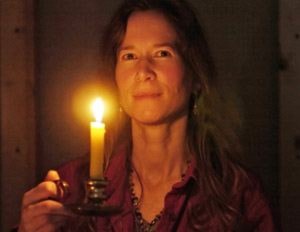Katy Delau’s house smells like a beehive.
And there’s wax all over the place.
But she doesn’t raise bees.
Delau’s a candle maker.
And she’s picky.
“I only burn beeswax candles,” said Delau, sitting at her table with a couple of them flickering.
Regular candles give off poisons when they burn, she said. Paraffin releases neuro-toxins, including acrolyn and stearic acid, which are both carcinogens.
“Burning paraffin candles is like breathing secondhand smoke, or sitting in a room with a diesel engine running,” said Delau.
Beeswax is harder and burns longer and doesn’t use poisonous additives, she said.
“But many people look at beeswax candles and think they’re expensive.”
In a tiny room in her trailer off the Carcross Road, Delau was liquefying a big block of beeswax in her new $3,000 wax melter.
Before getting this fancy equipment, Delau melted her wax on a propane burner outside.
“And when I carried it in, I would spill wax,” she said.
“It’s all through the house, everything’s covered in it. It’s even under my fingernails.
“But I guess there are worse things I could have everywhere.”
On a cookie tray, Delau lined up several rows of tiny silver cups, and started pouring some tea lights.
She filled the little cups above the brim, in a precarious bubble.
The wax shrinks as it hardens, she said, carefully placing wicks in each light.
Delau remembers making candles with her mom as a child, but it didn’t become a passion until much later in life.
“I was in Telluride, Colorado, visiting a friend,” she said.
“And I met this guy who lived in a little cabin, ‘cause he couldn’t afford rent, and his only light was from homemade beeswax candles.”
He showed Delau how to make them, and she began to experiment. She even tried collecting her own wax, but it proved hard to clean.
“There was lots of wings, some dead bees and sediment from the pollen in it,” she said.
“And the impurities would clog the wick and make it drip everywhere.”
Now, she orders 13.5-kilogram blocks from an Albertan supplier and pays about $5 for just under a kilogram.
The price of wax has risen in the past few years, said Delau.
“The bees are getting sick and getting diseases and wax is becoming harder to get.
“It’s a huge concern, because it’s bees that pollinate our fruit and veggies.”
Lifting off the large, stainless steel lid, Delau tested the wax.
It was too hot. “It should be about 160 degrees (Fahrenheit) before you start dipping candles,” she said.
On the shelf behind her, yellow beeswax Buddhas sat beside obelisk pillars and wax goddess ornaments.
“I’m not a Buddhist,” she said.
“But I appreciate the beliefs. The Buddha teaches non-attachment — so, burn the Buddha,” she said with a laugh.
The wax Buddhas are formed in a malleable latex mould Delau ordered from Germany.
“You don’t even have to clean these ones,” she said, popping out the newest plump, smiling sage.
The metal moulds, used for the majority of her standing candles need to be heated after each use, to melt out the wax residue. Then Delau wipes them out with toilet paper and coats them with olive oil before their next use.
“I was using Pam spray to grease them,” she said.
“But it just didn’t seem right with the purity of the beeswax, and the olive oil works well.”
Once the wax was ready, Delau lowered a frame strung with wick into the vat. It makes 17 candles.
After the first dip, she worked out the wax irregularities with her fingers, rubbing the thinly coated wicks. Then she slowly dipped the whole apparatus again.
To make sizeable candles, the wicks need to be dipped at least 30 times. And the whole process takes upwards of an hour, with Delau waiting a few seconds between each dip.
“I really love it,” she said.
“I think about other things while I’m working.
“And dipping candles is how I started.”
After working a couple summers in the Yukon, Delau moved north, and planned to get a Masters in social work.
But after having her son Solon, she changed pace and began making more and more candles.
“It’s a great home-based business,” she said.
“Although my husband jokes I make about 5 cents an hour.”
But Delau keeps getting busier.
“I’ve been burning the candle at both ends lately,” she said with a laugh.
There have been lots of late nights, and it’s not a very kid-friendly profession, she added watching her five-year-old son Solon playing with a great train set on the floor.
Apparently, Solon is already rolling his own colourful beeswax candles.
Delau buys the flat wax sheets for colour variety, because she just can’t bring herself to dye the rich, honey-coloured vats of wax.
“I love how it looks,” she said, holding up a pungent wax candleholder with pressed autumn leaves set in it.
The only thing Delau has ever added to her wax is fir needles, to give her ornaments a Christmassy smell.
Beeswax candles are a niche market, said Delau, who’s the only local retailer.
“But, like an small business, once people figure out who you are, they keep coming.”
Before getting her new wax melter, Delau was worried about fulfilling demand.
“The last few winters it’s been hard just supplying Aroma Borealis,” she said.
And candle making is not a speedy process.
There’s lots of waiting around, while the wax heats, cools and the moulds set, she said.
“It’s a good thing I’m a patient person,” added Delau lowering the frame for another dip.
